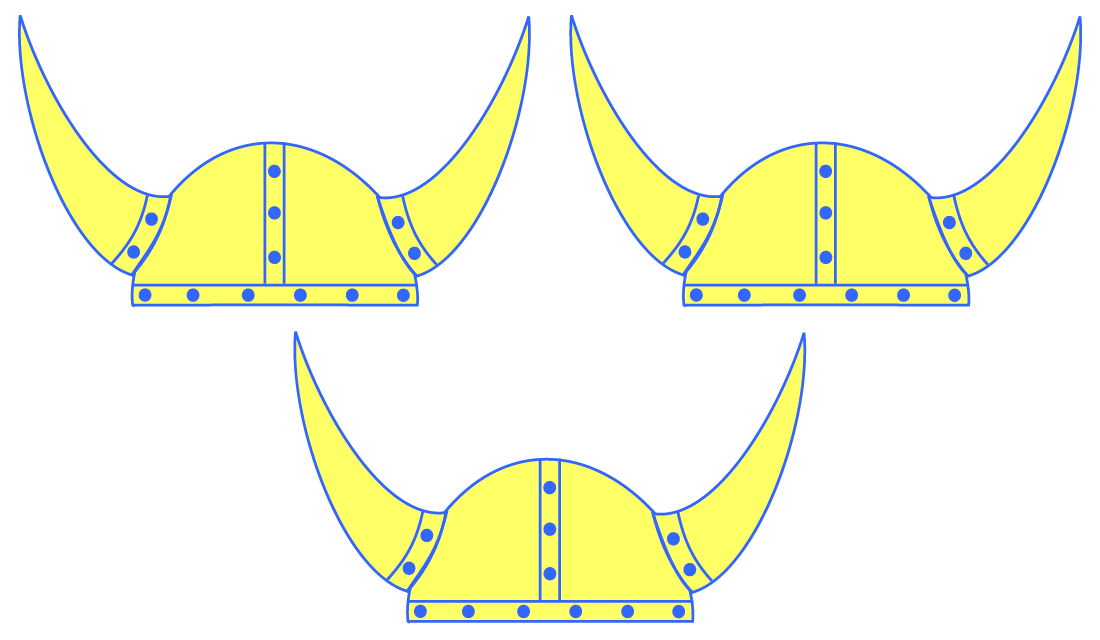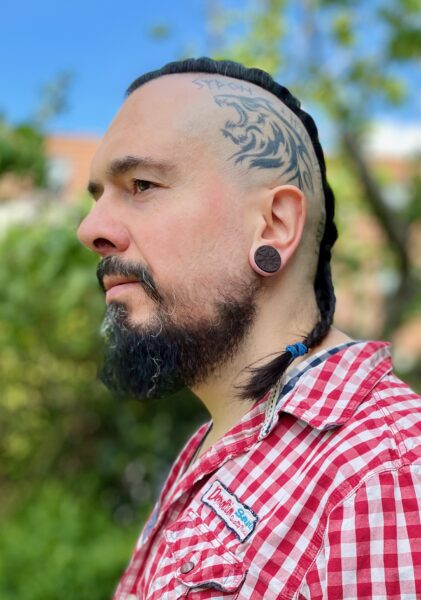
Ymir’s Corpse Interviews is a new Scandinavian Aggression initiative in which Rowdy Geirsson picks the metaphorical cloud-matter of authors and other artists who make their own creations based on or inspired by the old lore of the Northlands. First up to set things in motion is Bjørn Larssen. Bjørn is a writer based in the Netherlands and the author of Storytellers, Why Odin Drinks, and The Ten Worlds cycle, an original fantasy series set against the otherworldly backdrop of the Norse myths as they unfold on a collision course with Viking Age history. The first two volumes are Children and Land. Bjørn’s writing has been awarded a Readers’ Favorite Gold Medal and has been shortlisted for the Eric Hoffer Grand Prize Award as well as numerous Indie Ink Awards. He is a Queer Indie Award laureate and also a reviewer for Before We Go Blog and Queen’s Book Asylum.
RG: Welcome, Bjørn! I’m thrilled to have you on the website here to kick off the first-ever of this all-new Ymir’s Corpse Interview series. So, let’s jump right into your books, all of which deal with highly relevant subject matter—Norse mythology as well as Iceland at various stages of its history. One of the things I’ve wondered for sometime now is: what came first, your interest in the Norse myths or your interest in Iceland? (For any readers out there who don’t know, Storytellers is a mystery set in early 20th century Iceland while Bjørn’s other books are Norse fantasy.)
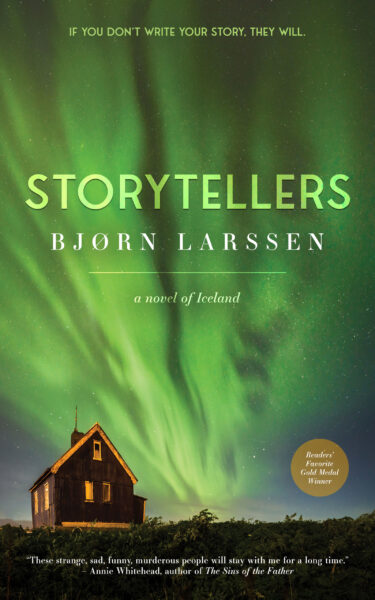
BL: First was the series Vikings, which I started watching mostly because Ragnar and Rollo kept taking their tops off. So, on this technicality, the Norse mythology was first. As for Iceland, I wrote the first draft of what would later become Storytellers listening to Ásgeir’s debut album, Dýrð í dauðaþögn, on repeat. I knew I needed a place that would be both desolate and claustrophobic. I needed some of those people to be fishermen, and it would be set in the early 20th century. I had no idea where to set the book until I had this sudden realization that Iceland is a real place, not just Björk’s accent. It also has Ásgeir and who knows what else? I bought a book called Wasteland With Words and it felt as if Iceland has been created especially so that I could set my book there.
In 2017 I went for a few days for a research trip. I fell in love with a thud and never quite recovered. Before the trip, I consulted the runes, and the answer was that I was going to the land of my ancestors, I would lose something there, and I will never guess what. Of course, I’ve spent the rest of the time and the entire duration of the trip trying to figure it out. The answer was “my heart.” If money wasn’t an issue, I’d be living in Iceland.
RG: I have to say, I think it’s quite fitting that you regard Vikings as an entry point to Norse mythology rather than Norse history. That series has proven really pivotal in the increase of interest in the subject matter that’s occurred in the past decade or so. But it also sounds like Iceland has committed a serious crime here: heart-theft! I understand the challenges with fully moving there, but perhaps another journey to go in search of your heart is in order? Perhaps Iceland’s own land spirits could have had something to do with this matter? I’ve heard rumors that you might have encountered one once.
BL: I’ve seen an elf one time—during that 2017 trip. But Grendel from Storytellers or the Hidden Folk of The Ten Worlds have nothing to do with the…being I have encountered. You’re not going to learn about Icelandic elves from my books. I’m going to be mysterious and finish here.
RG: Understood and probably a good idea. We don’t want to anger a vettir. So, then, where did the idea for The Ten Worlds cycle come from?
BL: I saw a photo of Prince Harry with Duchess Meghan (that was before Megxit). She’s an actress, so she was waving at the paparazzi, all smiles. He looked like a hunted animal, extremely uncomfortable, not wanting to be there at all. I had this thought—Prince Harry is really a nobody. He’ll never be King. The only reason why those paparazzi are there is that he is The Son Of. So, what would the Norse myths look like told by those marginalized in them—there are countless myths about Thor, but his son, Magni (one of the protagonists in The Ten Worlds) only really gets one mention. What would it be like to be Magni, someone whose only importance is being The Son Of one of the most powerful deities?
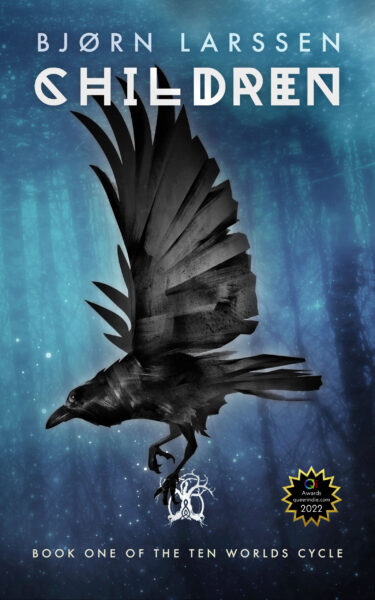
Maya—Freya’s foster daughter—doesn’t exist in the lore at all. She wasn’t meant to be in the book. But I am one of those authors who really write down what the characters tell them to. I binned a book after Storytellers, because it was a dumpster fire, but it had this character—a very thin, neurotic woman, always dressed in black, mid-length hair, not conventionally attractive, and asexual/aromantic. She just moved in when I was working on Children and took half of the book for herself. What sort of child could disappoint the Goddess of Love and God of Pleasure more than a girl who’s both asexual and aromantic? So, there’s a lot of parent issues, only those parents are nearly infinitely powerful and their children try to forge their own paths against expectations everyone else has for them, or doesn’t.
RG: And I think that’s one of its strongest aspects, too. Many books either star the major gods themselves, or feature human characters who call upon the big dogs, but it’s really quite rare to read original fiction lifting up figures such as Magni who is mentioned in passing in the old sources, but only just barely. The contrast in your portrayal of Magni and Maya with their parents is both delightful and sobering and works very well. For those of us who have read Children and Land, let’s just say that your character of Freya is…quite something! How did you settle on your characterization of her?
BL: I actually based her personality on Edina Monsoon from the British TV series, Absolutely Fabulous. Later on, when working on Why Odin Drinks, I started figuring out how she became like that, what sort of life experiences can shape a Goddess into, er, Eddie Monsoon. Only gorgeous. (In my imagination, I cast Scarlett Johansson as Freya. This is because I don’t like Scarlett Johansson.)
RG: Can I ask why not? Is she guilty of a crime more heinous than heart-theft?
BL: After she starred in Ghost in the Shell (where the protagonist is Japanese) and got slack for that, she huffed that she should be “allowed to play any person, or any tree, or any animal.” Ever since then I feel she should stick with tree roles. Or star as Freya!
RG: It’s fitting! And I suppose she could play Embla, too—just laying there immobile like a log on the beach while Odin and his brothers poke and prod her into life alongside whoever’s getting the same treatment playing the role of Ask. But getting back to the topic at hand: your The Ten Worlds books and Storytellers both tend towards grimdark or at least more somber territory, while Why Odin Drinks goes in the other direction of funny and quite zany! What’s it like writing books with such different moods?
BL: They’re not that different, really, only the proportions are different. The Ten Worlds is 90% dark and 10% inappropriate humor. Why Odin Drinks is the opposite. Out of the two, the “funny” books are more difficult to write, because humor is so subjective. I was raised on BBC sitcoms, so I’m sure lots of my references—and I do believe in pop culture references—fly right above Americans’ heads. So, the additional challenge is to make sure that the book is still funny if you don’t know why the egg whisk and the feather duster are in it. The Ten Worlds is more literary fantasy and yes, it’s grimdark AF (so I’ve been told), but most of the reviewers are grateful for the humor sprinkled throughout. I work much harder on the serious books, but the funny ones are more difficult to write. Does that make sense? Probably not, but it’s true.
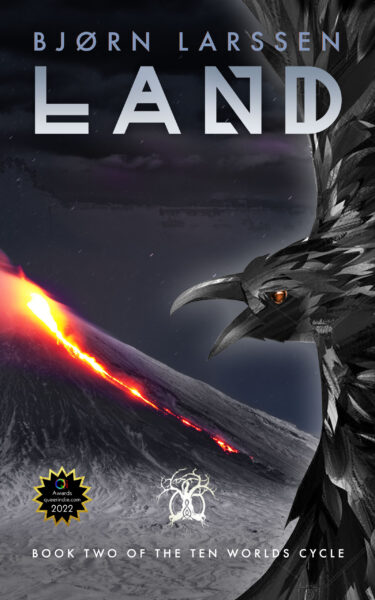
RG: It does, actually. I think The Ten Worlds in particular is a project with quite profound ambitions—I know there’s some intention on your part to ensure that certain side and future projects all adhere with consistency to the world (or worlds, as it were) of that series. What more can you tell us about that, and do you see the humor books as likewise conforming to the same worlds as depicted in The Ten Worlds?
BL: Yes, I have a canon. If, for instance, in Why Odin Drinks—in the story “Fortuneteller”—I mention that Frigg will never be a mother (I subscribe to the belief that Baldr was made-up later by Snorri, who wrote down the Norse lore 300 years after those who truly remembered it became extinct), then she can never be a mother in The Ten Worlds. And then the other way around, if you’ve read Children, you will know what I mean by the “singularity” in Why Odin Drinks. I have to remember what I have written where for this, and my memory is I forgot what, so I might end up making a wiki for myself. But it all forms one huge project divided into various genres. Not all of the Why Odin Drinks series is going to be slapstick comedy, by the way. I have a story called “Týr and Fenrir Wolf” that doesn’t fit either the Why Odin Drinks series or The Ten Worlds—I don’t know yet what to do with it.
In a horror anthology, Anatomy of Fear, I did a different retelling of the Týr/Fenrir story. That one is not canon. I keep feeling vaguely awkward about this. It’s not like anyone’s going to drag me… well, now that I mentioned this, someone definitely will… for that, but the Anatomy of Fear story is not my own canon, and I will have to mention that somewhere in the non-existent wiki.
RG: I don’t think you should worry too much about it—the old sources themselves are far from 100% consistent with themselves, so in a sense you’re actually continuing an ancient and time-honored tradition! And it gives you more freedom to explore the narratives from different angles via different tones, which is pretty cool. One of the things I’ve noticed that’s been a recurring element in your books that maybe has less to do with the Norse cosmos specifically is the craft of blacksmithing. It takes on a prominent role, particularly with Gunnar, the main character of Storytellers, and Magni, one of the two protagonists in The Ten Worlds, who we’ve touched on a little already. And I know you’ve had some experience as a blacksmith yourself. How has your own experience as a blacksmith influenced and informed the development of these characters?
BL: When my brother read Storytellers, he told me—amazed—that I was incredibly brave. “Why?” I asked. “You talk about your alcoholism so honestly,” he told me. I had to explain to him that just because Gunnar is a dark-haired, bearded blacksmith, that doesn’t mean I also make moonshine in my shed and get the shakes before my first spiked tea of the day! Anyway, because this wasn’t the question, it felt natural for me to write a blacksmith—also, I didn’t need to do research. I haven’t worked as one for a very long time (a back injury ended my career) but long enough to know what I was talking about. Gunnar’s back issues are my own back issues, this much I’ll give you (and my brother).
Magni is the son of Thor, who is the God of—among others—blacksmiths. Magni’s hammer isn’t magical and he doesn’t use it to smite the jötnar. Also, when he was eight but with a body of a thirty-year-old—he’s a God himself, even if he doesn’t want to be—he was given to the local blacksmith to raise, because his mother simply didn’t know what else to do with an eight-year-old stronger than any other man but his father. The job fits him. He’s extremely strong, incredibly focused, doesn’t want to fight, and just wants to be left to his own devices and make pretty, heavy things. But The Son Of doesn’t get to decide his own future, unless he’s very, very determined…
RG: The norns can be quite fickle in these sorts of scenarios. But speaking of fates and futures, do you have any other writing projects in the works you’d like to discuss? What can we look forward to next?
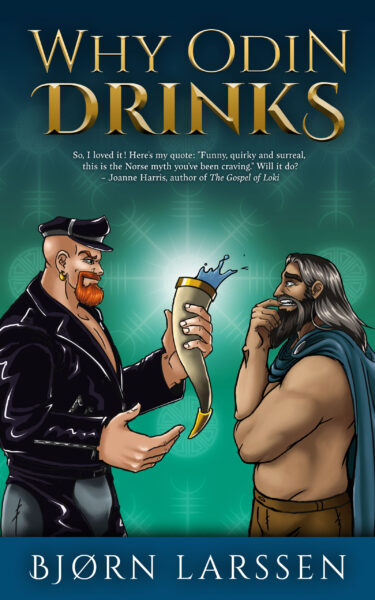
BL: I’m currently working on the follow-up to Why Odin Drinks. It’s called Bloodbath & Beyond and is largely Freya’s coming-of-age story. On the backburner, I have the third The Ten Worlds book, which I might divide into two; the first part is edit-ready, the second is a hot mess that needs lots of research. And finally there is the follow-up to Storytellers, which remains my best selling book, and if I had half a mind for business I’d set aside all this dumb Norse stuff and be on Storytellers 15—just Nordic historical suspense with perhaps an occasional irritating elf thrown in here or there. I didn’t have any ideas for years until one night I had a dream. I got up, grabbed the laptop, and over the next week or so banged out the entire outline for that book. So many WIPs, so little time 🙂
RG: Which isn’t necessarily a bad problem to have 😉 Plus, we all need an irritating elf once in a while, as well as Norse stuff—which isn’t dumb! Do you have a sense of which of these will be ready for release first and when that might be?
BL: Bloodbath & Beyond is nearly edit-ready. I have actually sent the first chunk to my editor already and the second part is almost at the right stage, too. I expect it to be published this year. The third book in The Ten Worlds series is loooooong and very difficult to write; it requires lots of research, especially regarding Harald Fairhair, and to be honest my interest in Fairhair’s conquests is zero. I can’t help it, though. He did the same thing as Maya before, moved into the book and announced he’ll be in half of it. (Hence my thought of dividing it into two parts, before and, um, during Harald.)
RG: It’s definitely at least somewhat symbolically fitting to use Harald as a “before and after” device for the two volumes. I hope the research goes well…and it sounds like we’ll get to see and read Bloodbath & Beyond before the year is over! I certainly look forward to that. But now, for one last question, just for fun: if you could step into the shoes of any figure from any Norse myth or legend, who would you choose and why?
BL: Ohhh. Let me overthink this. *opens Crossley-Holland’s Penguin Book of Norse Myths* Do you know, nothing springs to mind. All of those Gods and mortals seem to end up quite badly. Maybe I’d just be Magni. He’s an autobiographical character anyway, and in the entire lore only gets one bit for himself—after Thor’s battle with Hrungnir. When Thor lies crushed by Hrungnir’s leg, four-year-old Magni comes for his rescue, already stronger than his father, and gives a long speech, as four year olds do. The next and last mention he receives is inheriting Mjölnir after Ragnarök, which he survives. Yeah, I’d like to be Magni and give Dad a long talk after rescuing him, aged four.
RG: I’d pay money to hear you as the barely-post-toddler Son Of give the Thunderer a good talking-to! And I think that mental image is a great way to wrap up our little chat here. Thanks so much for taking the time to talk to today!
BL: Thank you so much for having me and for questions that made me (over)think!
Dear Web Prowler, since you’re here, please check out Bjørn Larssen’s work and give him a follow on social media via the links below:
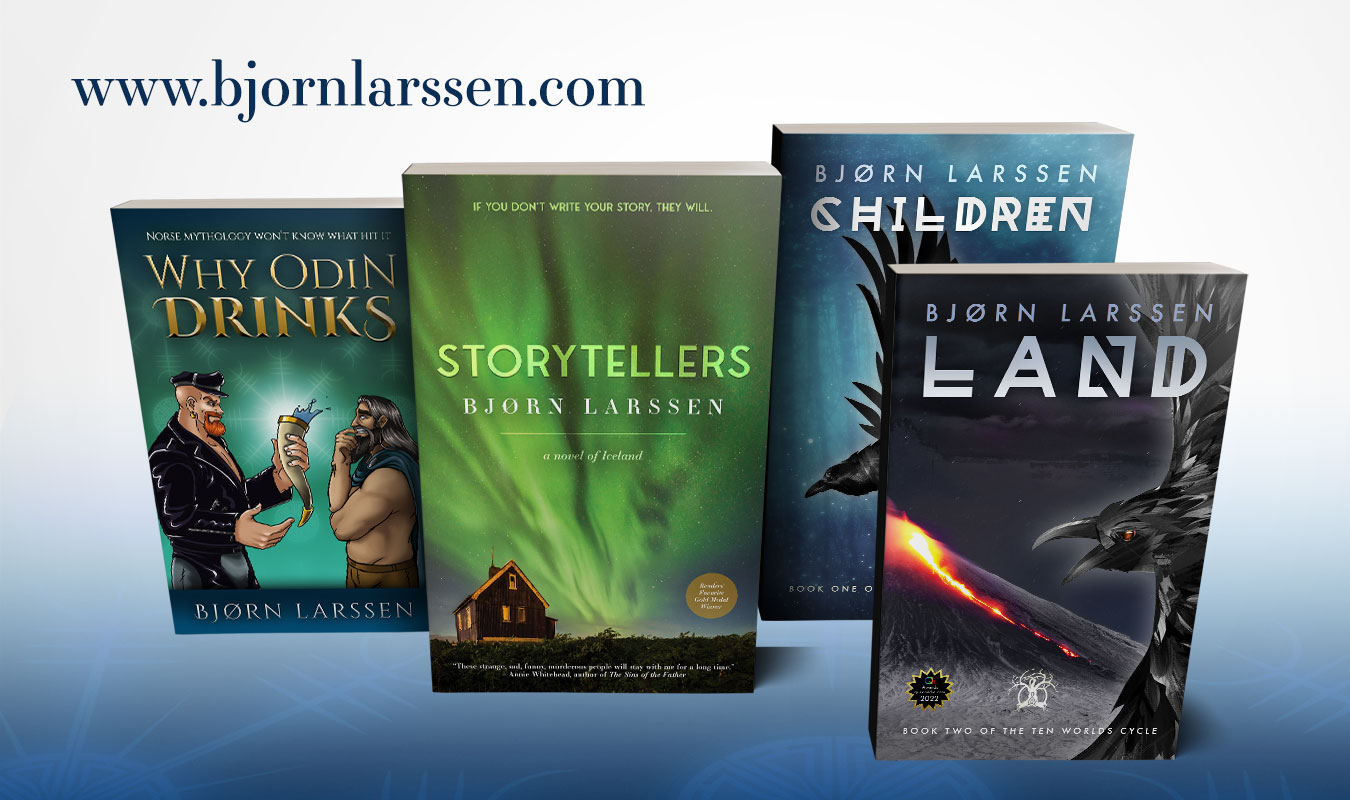
The images associated with this interview are all © Bjørn Larssen
Subscribe to get updates from Scandinavian Aggression!
You know, if you feel like it or whatever. Your email is only used to send updates when new nonsense has been posted to the site. It's stored in the secure abyss of WordPress and not shared anywhere or anyhow else. Skål som fan!
